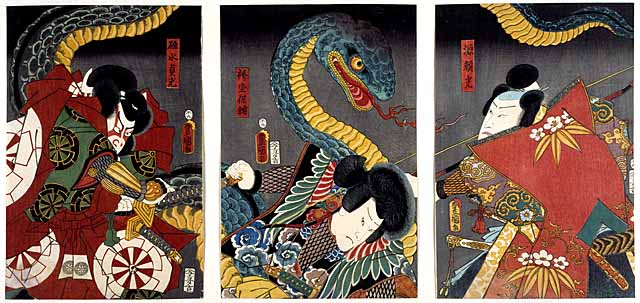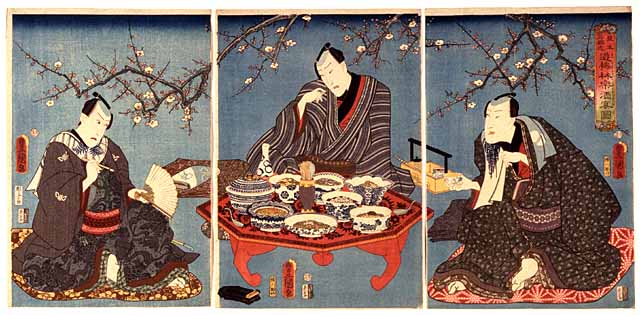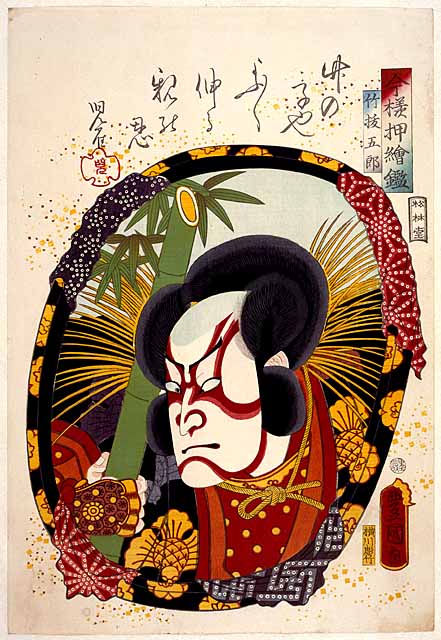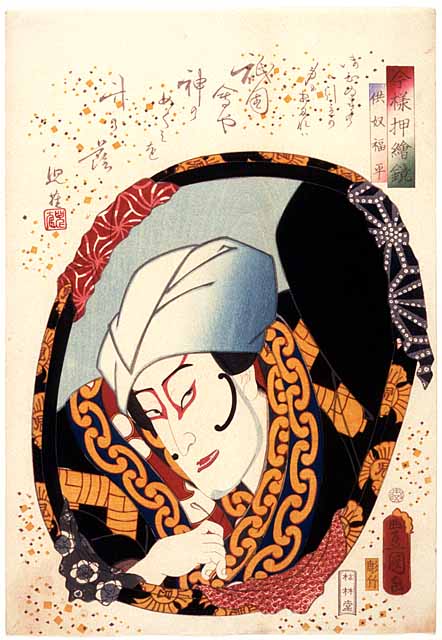
Nakamura Fukusuke I as Minamoto no Raiko(right), Ichikawa Ichizo III as Hakamadare Yasusuke (centre) and Kawarazaki Gonjuro I as Usui Sadamitsu (left) 1858/12
Kunisada 51
Given by the Friends of the Fitzwilliam with the aid of the MGC Purchase Grant Fund and the National Art Collections Fund.
A triptych of a battle with a giant snake featuring Minamoto no Yorimitsu, or Raiko (944-1104), who according to legend, was supposed to have rid Japan of many perilous demons.
Collections Record: P.74-1999

Mitate Sangoku-shi bairin ni asondeshuen o tanoshimu zu (Comparison with ‘Romance of the Three Kingdoms’: Picture of enjoying a banquet in the plum orchard)
Kunisada 53
01/1859
Given by the Friends of the Fitzwilliam with the aid of the MGC Purchase Grant Fund and the National Art Collections Fund.
A triptych published by Ebisuya Shoshichi of the Kabuki actors Nakamura Fukusuke I (right), Ichikawa Ichizo III (centre) and Kawarazaki Gonjuro I (left), enjoying a picnic in a plum orchard. The print alludes to the famous scene in which the three heroes of the Chinese kingdom of Shu (Guan Yu, Liu Bei and Zhang Fei) exchanged oaths of brotherhood while drinking wine in a peach orchard. Their tale was best known through the Chinese novel Romance of the three kingdoms, which was introduced into Japan in the early Edo period and remains popular today. The orchard scene often appeared in paintings and prints, such as the surimono by Kunisada.
Collections Record: P.76-1999

Nakamura Fukusuke I as Soga no Goro in Yayoi-zakura hisago no makubari, performed at the Nakamura theatre from 09/03/1860
Kunisada 58
Given by the Friends of the Fitzwilliam with the aid of the MGC Purchase Grant Fund and the National Art Collections Fund. From the series Imayo oshi-e kagami (Up-to-date Padded Pictures in Mirrors). Kunisada designed several series of portraits of actors reflected in mirrors. Six prints from this series are included in this exhibition.
This print of ‘bamboo-tugging Goro’ illustrates the scene in this Spring play (yayoi kyogen) in which the dance skit Edo-ganoko ninin Dojo-ji is performed.
The printing includes burnishing (tsuya-zuri) on the black. The seal of the leading block-carver Yokokawa Takejiro appears on the print.
Collections Record: P.81-1999

Nakamura Fukusuke I (Shikan IV) as Tomo-yakko Fukuhei
Kunisada 60
08/1860
Given by the Friends of the Fitzwilliam with the aid of the MGC Purchase Grant Fund and the National Art Collections Fund.
From the series Imayo oshi-e kagami (Up-to-date Padded Pictures in Mirrors). Kunisada designed several series of portraits of actors reflected in mirrors. Six prints from this series are included in this exhibition.
The act entitled Tomo yakko was a Yakko mono (‘footman play’) that originally formed part of the quick-change dance play Nijiri Gaki Nanatsu Iroha. The role of the footman was made famous in 1828 by its first exponent Shikan II (adoptive father of Fukusuke I), so Tomo Yakko was sometimes known as the ‘Shikan play’ (Shikan mono) and the character usually wore the Shikan mon (crest) on his costume. The piece involves the colourfully dressed footman, something of a dandy, performing a dance with exaggerated steps (tanzen roppo).
The printing includes blind embossing (karazuri) and burnishing (tsuya-zuri) on the black. The seal of the leading block-carver Yokokawa Takejiro appears on the print.
Collections Record: P.83-1999

Nakamura Shikan IV as the guard Matsuo-maru in Sugawara denju tenarai kagami (Sugawara and the secrets of calligraphy) performed at the Ichimura theatre from 17/10/1861
Kunisada 62
Given by the Friends of the Fitzwilliam with the aid of the MGC Purchase Grant Fund and the National Art Collections Fund.
From the series Tosei jihitsu kagami (Mirror of Contemporary Autographs), published 12/1861, with portraits by Kunisada juxtaposed against landscapes or still-lifes. This print, published in 11/1861, was one of several designed by Kunisada in connection with the same production, three of which are included in this exhibition. Here the villain Matsuo-maru appears in the scene called Kuruma biki (Pulling the carriage apart), which the Kabuki version had added to the original puppet play. The stage setting is conjured up in the hokku poem, signed in imitation of the actor’s own calligraphy, which appears to the left on the tanzaku (long poem card) decorated with pine needle and cone motifs:
- Kamigaki ya Within the shrine fence
- yo no ki wa nakute none of the other trees
- matsu no hana is as flowery as the pine.
The poem puns on the word matsu, ‘pine’, which forms part of the name of Matsu o-maru. The scene is set at Yoshida Shrine in Kyoto, with stage props usually including a torii gate, a low red kamigaki shrine fence (as mentioned in the poem), and cherry (sakura) and plum (ume) trees in reference to the names of Matsuo-maru’s triplet brothers, Sakura-maru and Ume o-maru. By comparing the trees, the poem also suggests that the role of Matsuomaru is more prominent than the others in this play.
Collections Record: P.85-1999



